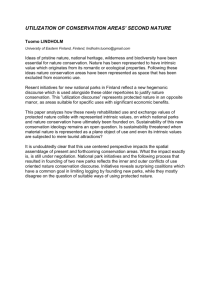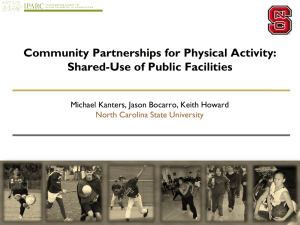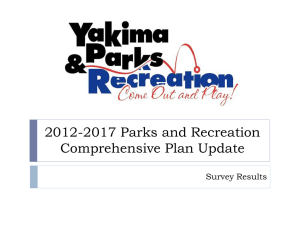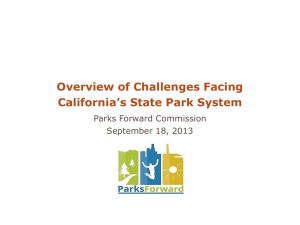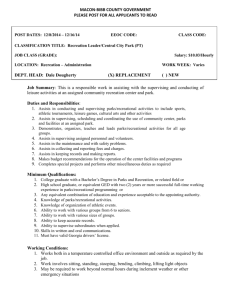Christenson Land Con..
advertisement
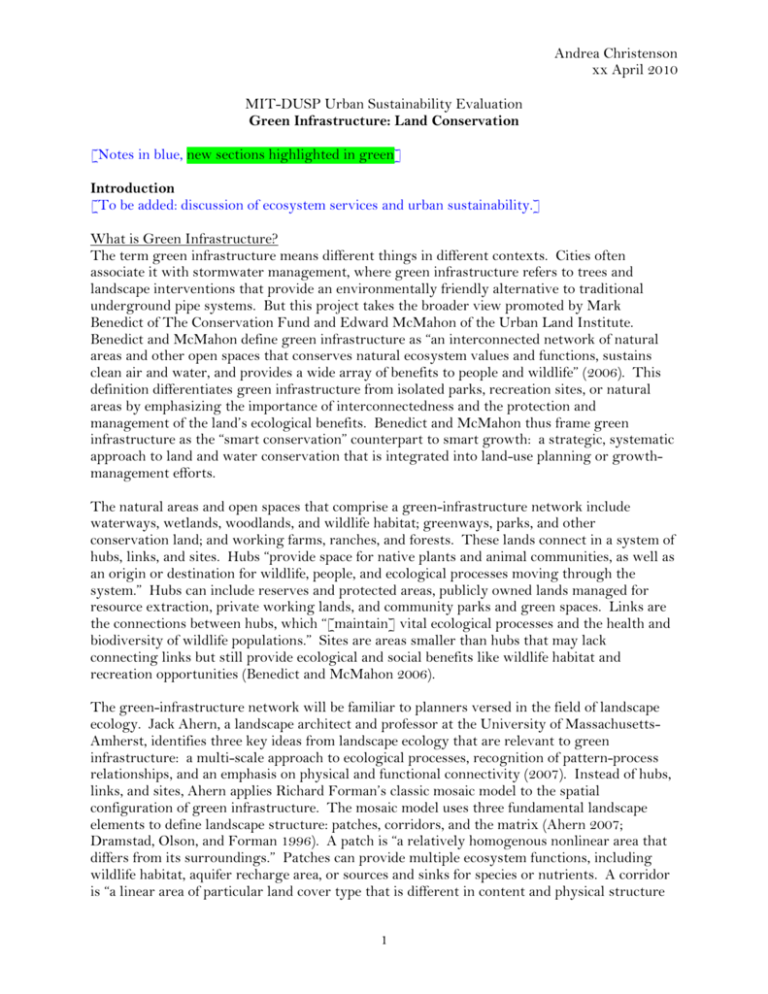
Andrea Christenson xx April 2010 MIT-DUSP Urban Sustainability Evaluation Green Infrastructure: Land Conservation [Notes in blue, new sections highlighted in green] Introduction [To be added: discussion of ecosystem services and urban sustainability.] What is Green Infrastructure? The term green infrastructure means different things in different contexts. Cities often associate it with stormwater management, where green infrastructure refers to trees and landscape interventions that provide an environmentally friendly alternative to traditional underground pipe systems. But this project takes the broader view promoted by Mark Benedict of The Conservation Fund and Edward McMahon of the Urban Land Institute. Benedict and McMahon define green infrastructure as “an interconnected network of natural areas and other open spaces that conserves natural ecosystem values and functions, sustains clean air and water, and provides a wide array of benefits to people and wildlife” (2006). This definition differentiates green infrastructure from isolated parks, recreation sites, or natural areas by emphasizing the importance of interconnectedness and the protection and management of the land’s ecological benefits. Benedict and McMahon thus frame green infrastructure as the “smart conservation” counterpart to smart growth: a strategic, systematic approach to land and water conservation that is integrated into land-use planning or growthmanagement efforts. The natural areas and open spaces that comprise a green-infrastructure network include waterways, wetlands, woodlands, and wildlife habitat; greenways, parks, and other conservation land; and working farms, ranches, and forests. These lands connect in a system of hubs, links, and sites. Hubs “provide space for native plants and animal communities, as well as an origin or destination for wildlife, people, and ecological processes moving through the system.” Hubs can include reserves and protected areas, publicly owned lands managed for resource extraction, private working lands, and community parks and green spaces. Links are the connections between hubs, which “[maintain] vital ecological processes and the health and biodiversity of wildlife populations.” Sites are areas smaller than hubs that may lack connecting links but still provide ecological and social benefits like wildlife habitat and recreation opportunities (Benedict and McMahon 2006). The green-infrastructure network will be familiar to planners versed in the field of landscape ecology. Jack Ahern, a landscape architect and professor at the University of MassachusettsAmherst, identifies three key ideas from landscape ecology that are relevant to green infrastructure: a multi-scale approach to ecological processes, recognition of pattern-process relationships, and an emphasis on physical and functional connectivity (2007). Instead of hubs, links, and sites, Ahern applies Richard Forman’s classic mosaic model to the spatial configuration of green infrastructure. The mosaic model uses three fundamental landscape elements to define landscape structure: patches, corridors, and the matrix (Ahern 2007; Dramstad, Olson, and Forman 1996). A patch is “a relatively homogenous nonlinear area that differs from its surroundings.” Patches can provide multiple ecosystem functions, including wildlife habitat, aquifer recharge area, or sources and sinks for species or nutrients. A corridor is “a linear area of particular land cover type that is different in content and physical structure 1 from its context.” Corridors can also provide wildlife habitat, serve as pathways for the movement of plants, animals, nutrients, and wind, or act as barriers to such movement. Finally, the matrix is “the dominant land cover type in terms of area, degree of connectivity and continuity, and control that is exerted over the dynamics of the landscape” (Ahern 2007, 271). Benefits of Green Infrastructure [To be added] Ahern applies the Abiotic, Biotic, and Cultural (ABC) resource model for landscape planning to articulate the key ecological functions of a green urban infrastructure (Table 1). Table 1: Key abiotic, biotic, and cultural functions of green infrastructure Abiotic Surface-groundwater interactions Biotic Habitat for generalist species Soil development processes Maintenance of hydrological regime(s) Accommodation of disturbance regime(s) Buffering of nutrient cycling Habitat for specialist species Species movement routes and corridors Maintenance of disturbance and successional regimes Biomass production Sequestration of carbon and greenhouse gases Modification and buffering of climatic extremes Provision of genetic reserves Support of flora-fauna interactions Source: Ahern 2007, 269 2 Cultural Direct experience of natural ecosystems Physical recreation Experience and interpretation of cultural history Provide a sense of solitude and inspiration Opportunities for healthy social interactions Stimulus of artistic/abstract expression(s) Environmental education Implementation Tools Cities wield a variety of tools to protect and restore lands with natural-resource value. We have divided these tools into five categories: planning, land acquisition, zoning ordinances, development ordinances, restoration and management, and education and incentives. The policies and programs within each category are listed in Table 2. Table 2: Green infrastructure implementation tools Category Planning Policy or program Environmental inventories and suitability studies Natural resource element in comprehensive plan Habitat conservation plan Fee-simple acquisition Conservation easements Large-lot zoning Conservation/cluster subdivisions Conservation overlay zoning Open space zoning Agricultural or timber management zoning Promotion of compact urban form Urban growth boundary Environmental impact review Park and open space impact fees Land dedication requirements Mitigation requirements Transfer of development rights Purchase of development rights Stream, wetland, and lake buffers Tree and vegetation protection Shoreline protection Viewshed protection Hazard area protection Regulation of site features Habitat restoration Invasive species eradication Sustainable public land management Tax incentives Landowner education campaigns Technical assistance Land acquisition Zoning ordinances Development ordinances Restoration and management Education and incentives This paper provides an overview of the policies and programs that cities implement in each of these categories. Twenty-three cities were selected for review: Austin, TX Boston, MA Boulder, CO Cambridge, MA Chattanooga, TN Chicago, IL Denver, CO Detroit, MI Houston, TX Jacksonville, FL Los Angeles, CA Milwaukee, WI Minneapolis, MN New York, NY Philadelphia, PA Pittsburgh, PA 3 Portland, OR Salt Lake City, UT San Diego, CA San Francisco, CA Santa Monica, CA Seattle, WA Washington DC Planning Although land-acquisition programs will always be somewhat opportunistic, sound planning provides an essential foundation for a city’s natural-resource protection programs and policies. Planning should inform and guide acquisition programs, regulatory ordinances, and restoration and management efforts. Environmental planning practices commonly employed by cities include environmental inventories and suitability studies, the incorporation of natural resourcerelated elements in a city’s comprehensive plan, and the preparation of habitat conservation plans under the Endangered Species Act. Environmental Inventories and Suitability Studies Natural-resource mapping has come a long way since the publication of Ian McHarg’s Design with Nature in 1969. With the advent and increasing availability of geographic information systems (GIS), local governments can now obtain and produce data and create accurate and sophisticated maps of the location and extent of environmental features. Cities can augment or validate their base maps with field studies by scientists on staff or retained as contractors. The preparation of an environmental inventory has thus become a routine task in land-use planning. An environmental inventory involves gathering information on and mapping a number of natural and socioeconomic features that have a bearing on land use. The components of an inventory will vary based on the characteristics of the area being studied and the city’s planning objectives. Natural features often include soil types and geologic conditions, slope and elevation, watersheds and flood plains, streams, water bodies, and wetlands, groundwater resources and their recharge areas, vegetation and wildlife habitats, productive farmland, and scenic viewsheds. The inventory should identify the location, quantity, and quality of these resources, and their vulnerability to development or overuse. Socioeconomic features can include land use and zoning, property boundaries and ownership, transportation infrastructure, sewers, historic and archaeological sites, and population trends (Randolph 2004; Arendt 1999; Daniels and Daniels 2003). The environmental inventory assembles spatial data but generally leaves the analysis and evaluation of the information up to the map user. Some cities take the inventory a step further by combining individual factors into land suitability studies. The objective of a suitability study is to determine the appropriate locations for certain land uses based on an area’s natural and socioeconomic features. Land-use suitability is determined by delineating the natural features that are vulnerable to development (e.g., habitats, wetlands, prime agricultural soils, viewsheds) from those features that are attractive for development (e.g., lack of natural hazards, stable slopes, road access, proximity to sewer and water infrastructure). For example, maps of flood plains, steep slopes, and expansive soils can be combined to show a composite of natural hazards. Land can then be rated as poor, fair, or good for development based on the combination of hazards present (Randolph 2004; Daniels and Daniels 2003). Table 3: Environmental inventories City Austin Environmental inventory Draft Community Inventory Components Natural Environment chapter Parks and Recreation chapter Physical Environmental Constraints Water Resources Environmental Inventory and Analysis section Comprehensive plan maps Boston Open Space Plan 2008-2012 4 Boulder GIS layers Cambridge Open Space and Recreation Plan 2008 Chattanooga Comprehensive plan Chicago Chicago Natural and Wildlife Plan and Chicago Nature Areas Directory Comprehensive plan maps GIS layers GIS layers Comprehensive plan maps Denver Houston Jacksonville Los Angeles GIS layers Comprehensive plan text (no maps) GIS layers Milwaukee Comprehensive plan maps Minneapolis Minneapolis Plan for Sustainable Growth maps Comprehensive plan maps Pittsburgh Open Space, Parks, and Recreation Plan GIS layers Portland Natural Area Acquisition Strategy maps Natural Resources Inventory Update project Comprehensive plan San Diego Comprehensive plan maps GIS layers San Francisco Comprehensive plan maps Seattle GIS layers Washington DC CapitalSpace Draft Plan map District of Columbia Wildlife Action Plan Comprehensive plan maps 5 Floodplains, creeks, lakes and ponds, prairie dog colonies, vegetation Environmental Inventory and Analysis section County Profile/Existing Conditions chapter, Environment section Open space, habitat types Water aquifers and reservoirs Parks, lakes and ponds Waterways, parks, floodplains Soils, floodplains, wetlands, beaches and estuarine systems, coastal high hazard areas Parks, rivers and streams, flood zones Conservation element Lakes and streams, flood maps, geotechnical information, significant ecologic areas, topography, fire and wind hazard areas, hillside areas, recreation and parks facilities, watersheds Waterways, primary environmental corridor, parks, floodplains Watershed management organizations, regional environmental features, critical areas (river and wetlands), existing parks and open space, proposed regional parks and trails, planned parks and open space Parks, remnant native plant communities, future parkland and facility study areas and adopted plans In progress Floodplains, landslide prone areas, greenways, woodland areas Existing natural areas and vacant land, future scenarios for natural area protection In progress Natural Resource Inventory Background Report Steep slopes, multi-habitat planning area, watersheds, flood hazard areas, mineral resource zones, community plan designated open space and parks Flood zones, multi-habitat planning area, water features, faults, geologic hazards Existing open space, proposed open space, areas of liquefaction potential, areas of potential landslide hazard, areas of potential tsunami inundation Park boundaries, tree canopy, Environmental Critical Areas Ecologically sensitive resources Habitat inventory Tree cover, watersheds and waterways, steep slopes, existing parks Elevation, community gardens, floodplains, hydrology, soil types, water, watersheds, wetland types, wooded areas Cities with no environmental inventory components available online: Detroit, New York, Philadelphia, Salt Lake City, and Santa Monica. GIS layers The Comprehensive Plan A comprehensive plan (or a “master” or “general” plan) is a city’s blueprint for future growth and development. It provides a legal basis for the city’s zoning, subdivision, site plan, and other land-use regulations. It can also be used to achieve conservation objectives through the inclusion of natural resource-related goals, objectives, and strategies. Some states require local governments to adopt comprehensive plans and to include specific elements within them. For example, California state law requires cities to prepare a general plan that includes seven elements: land use, circulation, housing, conservation, open space, noise, and safety. The conservation element is intended to address the conservation, development, and use of natural resources, including water, forests, soils, rivers, and mineral deposits. The open-space element should detail plans and measures for preserving open-space for natural resources, outdoor recreation, public health and safety, and for agriculture (Fulton and Shigley 2005; Walsh, Roberts, and Pellman 2005). Other states do not mandate comprehensive plans but encourage their adoption and advocate the inclusion of specific elements. New York state statutes, for example, recommend 15 elements, including “consideration of agricultural uses, historic and cultural resources, coastal and natural resources, and sensitive environmental areas” and “existing and proposed recreational facilities and parkland” (Nolon 2003). Comprehensive planning requirements can also come from a city itself. For example, Austin’s charter mandates the preparation of a comprehensive plan that includes ten elements, including “a conservation and environmental resources element” and “a recreation and open space element” (The Code of the City of Austin, Texas). Cities may also choose to add additional optional elements if they wish. Popular natural resource-related optional elements in California cities’ general plans include agriculture, biological, coastal, environment, fire, flood control, forestry, parks and recreation, resource conservation, and water resources (Governor's Office of Planning and Research 2009). Table 4: Natural resource-related comprehensive plan elements City Austin Boulder Chattanooga Denver Detroit Jacksonville Los Angeles Milwaukee Comprehensive plan Imagine Austin Comprehensive Plan (in progress) Boulder Valley Comprehensive Plan (update in progress) Comprehensive Plan 2030 (2006) Denver Comprehensive Plan 2000 (undated) City of Detroit Master Plan of Policies (2009) City of Jacksonville 2030 Comprehensive Plan (2009) General Plan Framework (1995) General Plan Milwaukee Citywide Policy Plan (2010) 6 Natural resource-related element Conservation and Environmental Resources; Recreation and Open Space Environment Natural Environment; Public Spaces and Recreation Environmental Sustainability Environment and Energy; Parks, Recreation, and Open Space Recreation and Open Space; Conservation Coastal Management Open Space and Conservation Conservation (2001); Open Space (1973) Natural Resources Minneapolis Philadelphia Pittsburgh Minneapolis Plan for Sustainable Growth (2009) Philadelphia2035 (in progress) PLANPGH (in progress) Environment; Open Space and Parks Open Space; Environmental Resources Open Space, Parks, and Recreation Plan was prepared as first step of PLANPGH Portland Portland Plan (in progress) The Draft Portland Plan Handbook includes a Sustainability and the Natural Environment action area San Diego Recreation; Conservation City of San Diego General Plan (2008) San Francisco Environmental Protection (2004); San Francisco General Plan Recreation and Open Space (update in progress) Santa Monica Conservation; Open Space Santa Monica General Plan Seattle Toward a Sustainable Seattle (in progress) Current plan includes an Environment element Washington DC Environmental Protection; Parks, The Comprehensive Plan for the National Recreation, and Open Space Capital (2006) Cities with no natural citywide comprehensive plan: Boston, Cambridge, Chicago, Houston, and New York. Cambridge’s Toward a Sustainable Future: Cambridge Growth Policy Update (2007) has Open Space and Environment and Sustainability elements. Salt Lake City’s Creating Tomorrow Together report (1998) has a section on the natural environment. Habitat Conservation Planning In addition to the more general planning practices described above, a few cities have worked with the U.S. Fish and Wildlife Service to prepare a habitat conservation plan (HCP) under the Endangered Species Act (ESA). The ESA prohibits any activities that harm (or “take”) threatened or endangered species on public or private land.1 If a city wishes to develop land in the vicinity of a listed species’ habitat, it is required to obtain an incidental take permit from the Fish and Wildlife Service. To obtain a permit, the city must prepare a HCP. A HCP is a contract for large-scale ecosystem management. It identifies critical habitat areas where development is off-limits as well as lands where development is allowed. A HCP may apply to a single species or to several species, and may cover a small amount of land or up to thousands of acres. HCPs are time consuming and expensive to prepare, but “they represent some of the most sophisticated planning for natural resource protection now being undertaken in this country” (Duerksen and Snyder 2005; Daniels and Daniels 2003; Randolph 2004). California has established its own program for endangered species protection. The Natural Community Conservation Planning Act of 1991 aims to be broader, more flexible, and more predictable than the rules for federal HCPs. At the time, both conservation advocates and development interests were critical of the HCP process because it focused on one species and one project at a time. From the developer’s perspective, the project-by-project approach created costly delays, red tape, and uncertainty. To conservationists, it failed to address overall needs of species and populations at risk, did not prevent fragmentation of habitats and ecosystems, and did not provide habitat enhancement often needed for ecosystem conservation. In response, NCCP plans focus on regional ecosystems and multiple species (Randolph 2004). Table 5: Habitat conservation plans City Habitat conservation plan 1 Protected area (acres) Taking is defined very broadly, and includes destroying the species’ habitat in addition to causing direct physical harm. 7 Austin San Diego Seattle Balcones Canyonlands Conservation Plan (1996) City of San Diego Multiple Species Conservation Program Subarea Plan (1997) Cedar River Watershed Habitat Conservation Plan (2000) 8 30,428 56,831 90,546 Land Acquisition Land acquisition is a familiar and important tool for natural resource protection. Cities can acquire land or property rights through outright purchase, donation, or exchange. Purchases can be made at fair market value, at assessed value, or at a reduced rate. (Landowners may accrue tax benefits for bargain sales or land donations.) City programs often include two methods of land acquisition: fee-simple acquisition and conservation easements. Fee-simple Acquisition Fee-simple acquisition means that a city obtains full ownership of the land. There are several benefits to fee-simple acquisition as a conservation strategy. First, it can guarantee permanent protection. Second, it gives the city full control over the land. Ownership allows a city to prohibit all development in an area, whereas regulation can only restrict what is done on a particular parcel. Third, it enables a city to open the area to the public and to manage and oversee its use, both of which would be difficult under private ownership. And fourth, it may often be more politically palatable than strict regulations. (Duerksen and Snyder 2005; Randolph 2004). However, fee-simple acquisition also faces significant limitations. Purchasing land can be a complicated and time-consuming task that requires legal and financial expertise. Governments are not usually well positioned to conduct land transactions or compete in the real estate market. Funds appropriated for land conservation may not be available when a parcel comes on the market. Procedural requirements can result in a lengthy decision-making process, which puts government at a competitive disadvantage in the open market. Distrust of government among landowners and a strong sense of private property rights can also hamper negotiations. In addition, acquisition is usually the most expensive way to protect land. Even if the money were available to purchase every site with natural resource value, it would not necessarily be the best approach. First, government ownership removes land from the city’s tax base. Second, the lands being acquired will need to be managed, which can require high levels of both funding and staff time. Where the current land use is compatible with natural resource goals, a non-acquisition solution could enable the land to continue to function as before and engage the landowners in helping to protect the resources (Benedict and McMahon 2006). Conservation Easements A conservation easement is a legal agreement that restricts the use of private property in order to protect its conservation value. Landowners agree to give up specific rights regarding how the land will be used but can otherwise continue to enjoy the property as before. This concept is best illustrated by thinking about land ownership as a bundle of sticks. Each stick represents a landowner’s right to do something with his or her property: to develop a subdivision, build a house, farm, ranch, cut timber, and so on. With a conservation easement, a landowner sells or gives away some or all of these rights while still maintaining ownership of the land (Benedict and McMahon 2006). There are several advantages to conservation easements. First, they tend to be less expensive than fee-simple acquisition, and the fact that the land remains in private ownership allows it to remain on the tax rolls. Second, the extent of the restrictions is very flexible. A conservation easement can be written to prohibit industrial or commercial use of the property, restrict the number of residential units, or prohibit the construction of new roads. It might allow for 9 limited development by specifying parts of the land that cannot be developed or setting a maximum number of acres that can. Third, most conservation easements are permanent and “run with the land” if it is sold. This ensures long-term protection of the land’s natural resource value while allowing for private ownership and traditional uses (Benedict and McMahon 2006; Randolph 2004). 10 Table 6: Recreation and natural resource-focused land acquisition programs City Department Austin Parks and Recreation Water Utility Boston Parks and Recreation Boulder Parks and Recreation Open Space and Mountain Parks Public Works Chattanooga Community Development Parks and Recreation Chicago Chicago Park District Denver Parks and Recreation Detroit Houston Recreation Parks and Recreation Jacksonville Recreation and Community Services Los Angeles Minneapolis Recreation and Parks Park and Recreation Board New York Parks and Recreation Cambridge Types (and number) of properties Parks (206) Greenbelts (26) Preserves (12) Total area (acres) >17,576 (probably includes part of the BCP) 13,251 Balcones Canyonlands Preserve Parks Urban wilds Parks (>60) Open space and mountain parks Greenways Natural resource-specific divisions or programs --Nature Preserves System (960 acres) --Jointly manages part of the Balcones Canyonlands Preserve Conservation easements? --Urban Wilds Initiative 1,000 >45,000 Y 20 miles of stream corridors Parks Parks Greenways Parks (570) 4,000 Parks and parkways (>350) Denver Mountain Parks (46) 4,000 14,141 7,600 ? --Nature Oasis organizes programs and events in parks with unique and compelling natural areas --Denver Mountain Parks System --Natural Areas Program Parks (350) Greenspaces and esplanades (>200) Parks Nature parks (16) Preservation parks (14) Parks (>400) Parks Nature sanctuaries Scenic byway Parks Nature preserves (51) --Waterfront Management and Programming Division --Preservation Project Jacksonville 15,600 29,000 8,700 (probably included in 29,000) 11 ? --Natural Resources Group --NY/NJ Harbor Estuary Program --Forever Wild Program Philadelphia Pittsburgh Portland Fairmount Park Citiparks Parks and Recreation Salt Lake City Public Services San Diego Park and Recreation San Francisco Recreation and Park Santa Monica Community and Cultural Services Parks and Recreation Parks and Recreation Parks (63) Parks Parks Nature parks Parks (126) Open space areas (8) Parks (340) Open space parks (9) Canyon parklands (9) Parks Natural areas (35) 9,200 Parks (26) >10,000 --City Nature Division ? 1,912 --Open Space Lands Program Y 39,737 --Open Space Division ? 3,500 500 (probably included in 3,500) 122 --Natural Areas Program Parks and open areas (430) 6,200 Parks (50) ? Natural areas (4) Milwaukee is the only city that does not have a land acquisition program. The Department of Public Works provides 48 play areas and 11 “green areas that include benches for a natural setting in which to relax,” neither of which are included in our definition of parks. Parks within the city are owned and managed by Milwaukee County. Seattle Washington DC 12 Table 7: Watershed protection land acquisition programs City Department Total area (acres) Location Austin Water Utility 23,577 Travis and Hays Counties Cambridge Water Department Los Angeles New York Water and Power Environmental Protection Water Bureau Public Utilities Public Utilities Commission Public Utilities >1,200 (includes reservoirs) >314,000 104,000 (city and WAC) 5,000 23,773 63,000 Waltham, Lexington, Lincoln, and Weston Eastern Sierra Nevadas Catskill/Delaware watershed Mt. Hood National Forest Wasatch Mountains San Mateo, Alameda, and Santa Clara Counties King County Portland Salt Lake City San Francisco Seattle 99,000 13 Conservation easements? Y (14,527 acres) Y Table X: Summary of city programs and policies Habitat conservation plan Recreation focus Natural resource focus Watershed protection focus X X X X X Land acquisition Natural resource element in comprehensive plan City Austin Boston Boulder Cambridge Chattanooga Chicago Denver Detroit Houston Jacksonville Los Angeles Milwaukee Minneapolis New York Philadelphia Pittsburgh Portland Salt Lake City San Diego San Francisco Santa Monica Seattle Washington DC Environmental inventory Planning X X X X X X X X X X X X X X X X X X X X X X X X X X X X X X X X X X X X X X X X X X X X X X X X X X X X X X X X X X X X X X [I need to formalize which of the natural resource inventory elements “count.”] 14 X X Reference List Ahern, Jack. 2007. Green infrastructure for cities: The spatial dimension. In Cities of the future: Towards integrated sustainable water and landscape management, edited by V. Novotny and P. Brown. London: IWA Publishing. Arendt, Randall. 1999. Growing greener: Putting conservation into local plans and ordinances. Washington, D.C.: Island Press. Benedict, Mark A., and Edward T. McMahon. 2006. Green infrastructure: Linking landscapes and communities. Washington, D.C.: Island Press. Daniels, Tom, and Katherine Daniels. 2003. The environmental planning handbook for sustainable communities and regions. Chicago, IL: American Planning Association. Dramstad, Wenche E., James D. Olson, and Richard T. T. Forman. 1996. Landscape ecology principles in landscape architecture and land-use planning. Washington, D.C.: Island Press. Duerksen, Christopher, and Cara Snyder. 2005. Nature-friendly communities: Habitat protection and land use. Washington, D.C.: Island Press. Fulton, William, and Paul Shigley. 2005. Guide to California planning. 3rd ed. Point Arena, CA: Solano Press Books. Governor's Office of Planning and Research. 2009. The California planners' book of lists: 2010. Sacramento, CA: Governor's Office of Planning and Research. Nolon, John R. 2003. Open ground: Effective local strategies for protecting natural resources. Washington, D.C.: The Environmental Law Institute Randolph, John. 2004. Environmental land use planning and management. Washington D.C.: Island Press. The Code of the City of Austin, Texas. [cited March 23, 2010. Available from http://www.amlegal.com/austin_nxt/gateway.dll/Texas/austin/charter/articlexplann ing?f=templates$fn=default.htm$3.0$vid=amlegal:austin_tx$anc=LPTOC5. Walsh, Sean, Terry Roberts, and Shauna Pellman. 2005. California planning guide: An introduction to planning in California. Sacramento, CA: Governor’s Office of Planning and Research. 15 Andrea, You are now on track and making reasonable progress. As my comments suggest, we do need to make sure that your memo (and others) steer away from being literature reviews and actually focus on helping cities figure out what to do. This means that not all of what you know will be included in the text; the focus of what is included should be on what kinds of programs cities are using and what seems to be effective (and, eventually, on obstacles to implementation and ways of overcoming those obstacles). This is tricky with your topic because we need to specify what the desirable outcome is. (For example, with green stormwater infrastructure, it’s reduced flooding; with energy-efficiency programs, it’s reduced GHG emissions. So what’s the environmental objective that we can say your programs do more or less of? Conserving biodiversity and/or ecological function seem like obvious candidates. So how do we know how effective a particular program is at this??) You should continue to ponder these questions between now and our next meeting, but also see if you can get some of your colleagues on the team to hash it out with you. It’s a tough one. Judy 16



